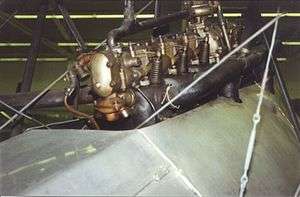Hiero 6
In 1914 Otto Hieronimus manufactured the six-cylinder Hiero E, also known as the Hiero 6 engine which was derived from earlier 4-cylinder engines. The Hiero engine like the Austro-Daimler powered many of Austria's World War I aircraft. Hiero aircraft engines were designed by Otto Hieronimus, a famous Austrian auto racer of the early 1900s. His initial designs were liquid-cooled inline engines built by the Laurin & Klement Automobile Works of Austria.
| Hiero 6 | |
|---|---|
 | |
| Hiero 6 engine of an Austro-Hungarian Phönix J.1 fighter biplane in a Swedish museum | |
| Type | 6-cyl water-cooled in-line piston engine |
| National origin | Austria |
| Manufacturer | Hiero / Laurin & Klement Automobile Works |
| Designed by | Otto Hieronimus |
Design and development
The Hiero E had a 135 mm x 180 mm bore/stroke (15.46L / 943.4cuin) and delivered 200-230 hp. The engine had the typical features of an inline vertical 6-cylinder: aluminum crankcase, cast iron cylinders, one inlet and one exhaust valve per cylinder controlled by bars and rockers, with the cam-shaft in the bed, and dual ignition by two Bosch magnetos. During World War I, the highly regarded Hiero engines were built under license by Essler, Warschalowski & Company of Vienna and the Breitfeld-Daněk company of Czechoslovakia. A point of recognition of Hiero engines compared with other Central Powers OHC inlines is that the intake was on the right and the exhaust on the left. After World War I, production was continued by the Avia company and powered a number of their early aircraft.
Variants
- Hiero 145 hp
- 145 hp (108.1 kW) (probably designated Hiero B or Hiero C )
- Hiero 185 hp
- 185 hp (138.0 kW) (probably designated Hiero D)
- Hiero B
- Hiero C
- Hiero D
- Hiero E
- 200 hp (149.1 kW) - 230 hp (171.5 kW)
- Hiero L
- Hiero N
- 230 hp (171.5 kW)
Applications
Specifications (Hiero E)
Data from World Encyclopaedia of Aero Engines.[1]
General characteristics
- Type: 6-cyl in-line Water-cooled
- Bore: 135 mm (5.31 in)
- Stroke: 180 mm (7.09 in)
- Displacement: 15,459 cc (943.4 cu in)
- Designer: Otto Hieronimus
Components
- Valvetrain: overhead-cam
- Cooling system: water
Performance
- Power output: 200 - 230 hp (149 - 172 hp)
See also
Comparable engines
Related lists
References
- Gunston, Bill (2006). World Encyclopaedia of Aero Engines (5th ed.). Stroud. ISBN 0-7509-4479-X.
Further reading
- Gunston, Bill. (1986). World Encyclopaedia of Aero Engines. Patrick Stephens: Wellingborough. p. 23
External links
| Wikimedia Commons has media related to Hiero 6. |